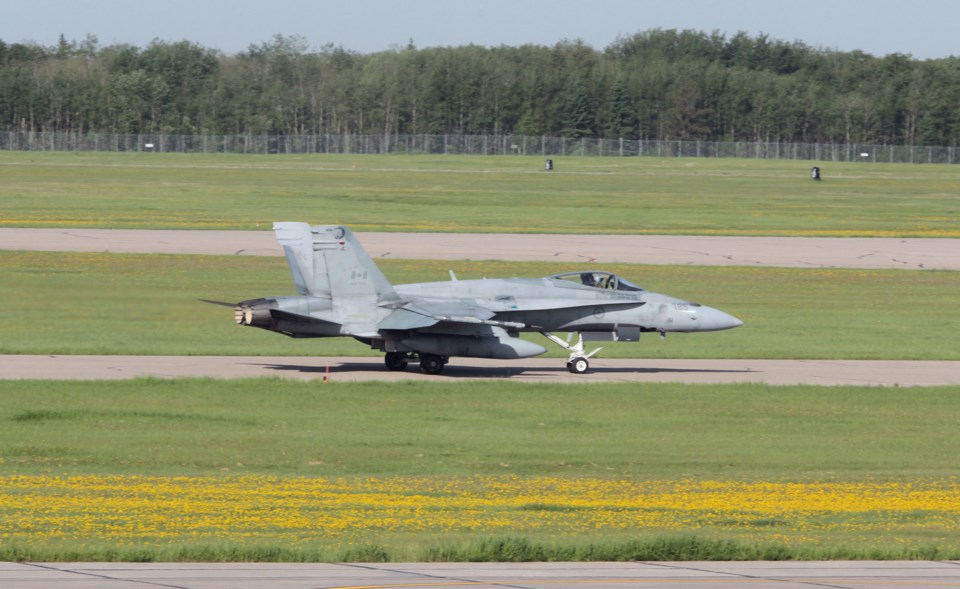The Royal Canadian Air Force's (RCAF) largest annual training exercise is underway in Cold Lake. May 29 marked the opening of the RCAF Maple Flag 50.
The Royal Canadian Air Force's (RCAF) largest annual training exercise is underway in Cold Lake.
May 29 marked the opening of the RCAF Maple Flag 50. Countries from all over the world sent their military air forces to Cold Lake for the unique training opportunity.
"We run a state-on-state training environment. It's not a low threat environment like the ones you would see in Iraq or Afghanistan right now. This is a much higher threat environment we're training in, against adversaries that have the capability to shoot down a fighter at 30,000 feet," informed air force tactical training centre commanding officer Maj. Chris Horch.
Over the course of the exercise, RCAF units will complete a series of training missions that simulate real world scenarios. They're involved in every aspect of each mission, beginning with the planning stage.
"It's a full four hours of planning for a single mission. A representative from each formation (transport, helicopter, and each fighter) show up to the initial meeting and that's where they come up with the master plan for the entire package," explained Horch. "The emphasis of the planning is to safely get fighters, transports, and helicopters into the target area, de-conflicted from one another while executing their mission. Whether that be dropping bombs on a target, inserting paratroopers or inserting soldiers via helicopters."
The morning after the initial meeting there is a 45-minute briefing for anyone involved in the mission. The mission itself takes an hour to run, but that doesn't mean the work is over.
Once the objective is complete, pilots will gather their squadrons and review footage of the exercise to find out if their shots were valid and their targets destroyed.
As an example, Horch gave a full rundown of what a joint personnel recovery case looks like.
"In this case we simulate two air crew being shot down deep in enemy territory. The goal of the blue air (friendlies) is to insert and defend against red air (enemies) and recover those personnel, but to do that they have to locate them," detailed Horch.
Fighters who navigate their way through red air will then attempt to find and protect the immobilized pilots.
"Air support fighters will push to geo-locate the downed air crew and provide close air support as required, dropping bombs in close proximity to friendlies to hold off enemy ground forces. Special forces will then insert a team that will jump out of the back of the CC-130J Hercules to establish protection for the downed air crew or help locate them, the recovery helicopters then pick up the downed crew and fly them back to friendly territory."
In addition to the search and rescue style missions, the RCAF also perform strike, dynamic target, and defensive air counter missions.
Both strike and dynamic target events require a pilot to hit a target, whether that be a drop zone for paratroopers or a building for a bomb. The difference in the two is during the strike, the pilot knows what their target is before they take off. During a dynamic target run-through, the pilot receives his targets in real time from a joint-terminal attack control team.
Defensive air counter missions are an air-to-air battle between friendly and enemy forces.
Horch admits the regimen for Maple Flag attendees is a rigorous one, but adds that it's worth it. He explained the RCAF continually receives feedback on Maple Flag from pilots deployed all over the world. The most recent example comes from the Canadian group that took part in operation impact in Syria.
"The feedback we received from the crew that flew in that top impact scenario was that Maple Flag prepared them for their mission overseas. Not only in how the mission was flown but also in how the mission was planned and briefed with coalition nations. They worked with the Americans, the Dutch, the Belgians, and aircrew from all over the world, some of them they met here in Cold Lake during previous Maple Flag training."
Even before the start of the second two-week period of Maple Flag 50, plans are already in motion for next year's event. Horch and the RCAF hope the recent real world validation of the exercise's practicality draws even more international attention to Cold Lake for Maple Flag 51.
